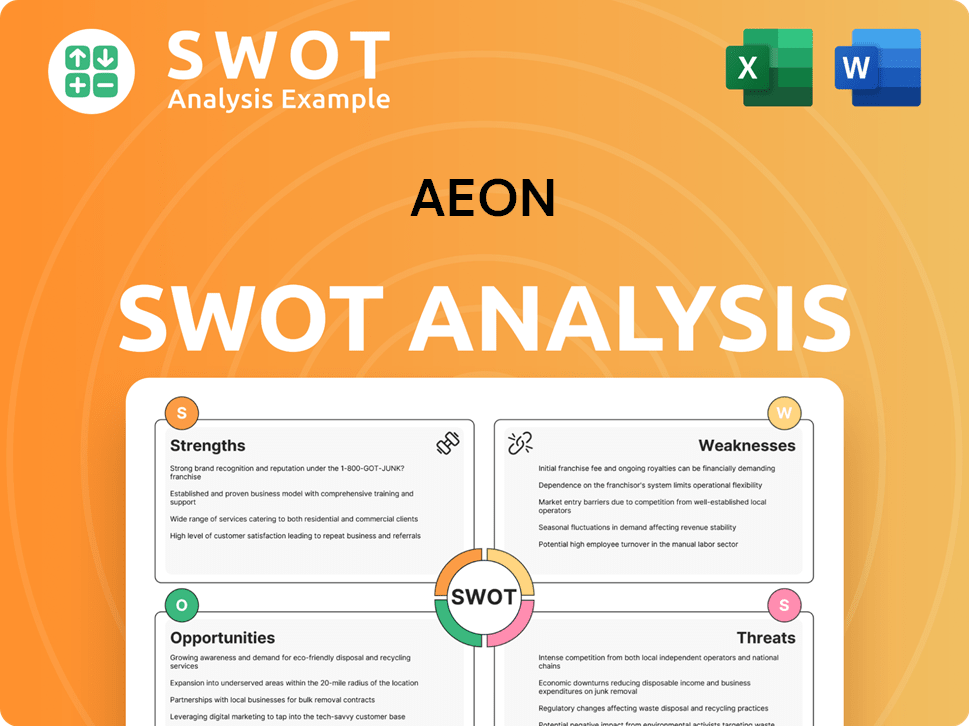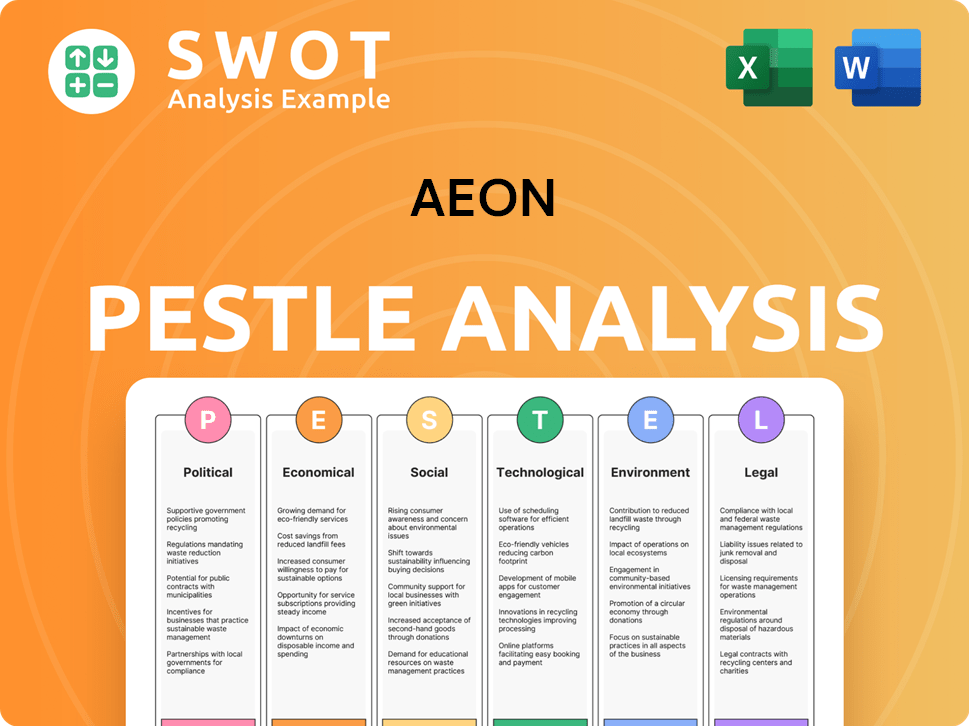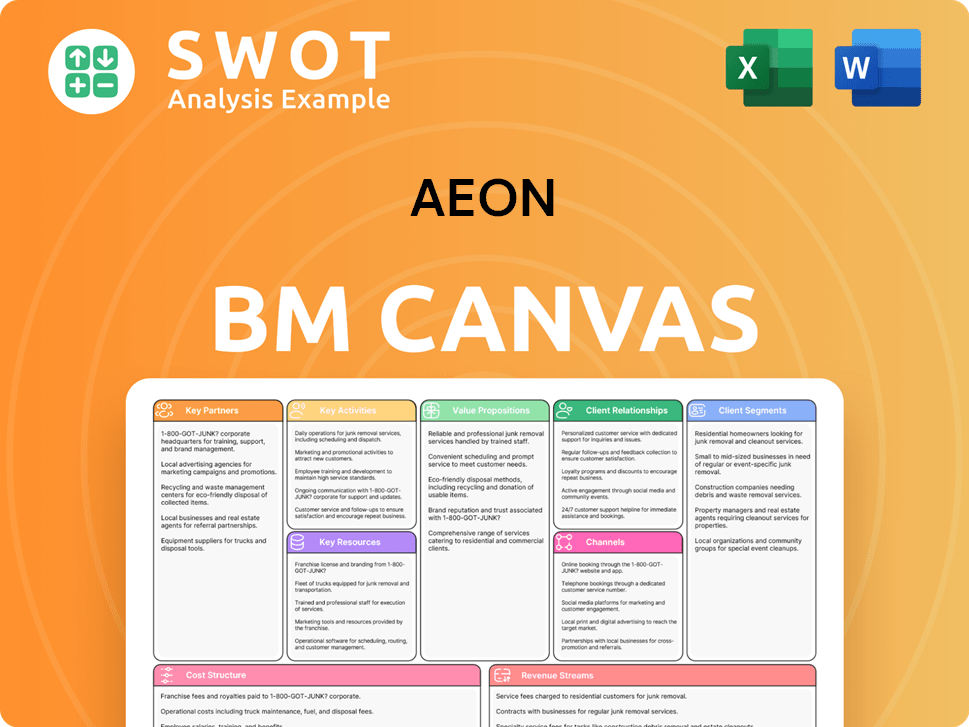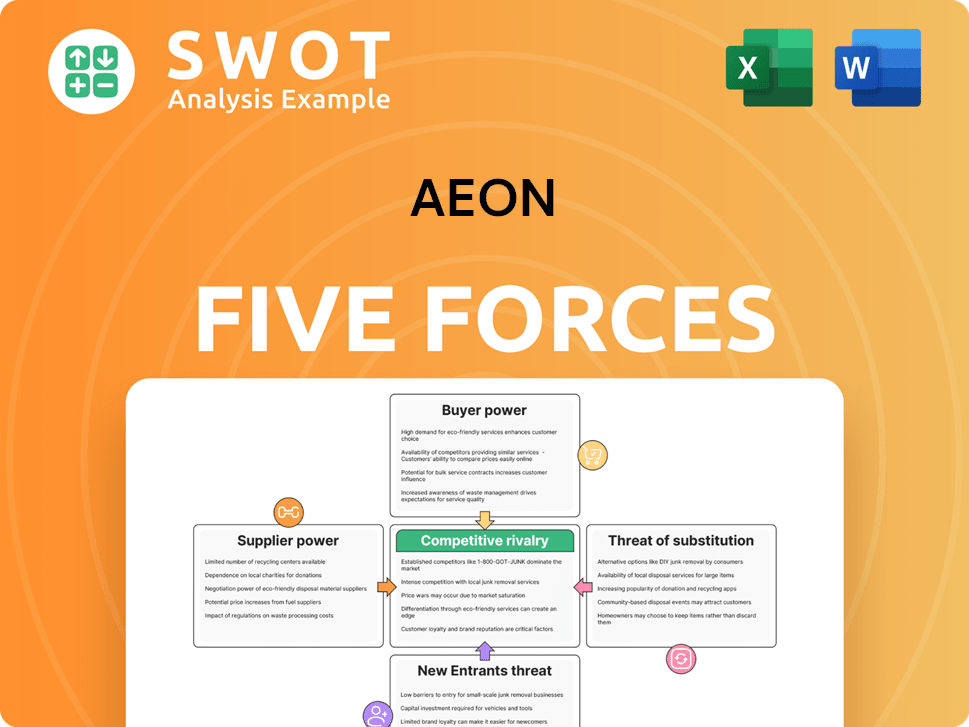Aeon Bundle
How did Aeon Company become a retail powerhouse?
Journey back in time to 1758 and uncover the remarkable Aeon SWOT Analysis of Aeon Company, a retail giant that began as a small shop in Japan. Witness its incredible transformation into one of Asia's largest retail conglomerates, driven by a relentless focus on customer satisfaction. Explore the pivotal moments, including the 1969 formation of JUSCO, that shaped its enduring success.

This brief history of Aeon Company details its impressive evolution, from its early years to its current status as a leader in the Japanese retail industry and beyond. Learn about the Aeon Group's strategic decisions and significant milestones that have propelled its growth, including key acquisitions and its expansion throughout Asia. Understanding the Aeon timeline provides valuable insights into its adaptability and its ongoing impact on the economy, making it a fascinating study for anyone interested in the retail sector.
What is the Aeon Founding Story?
The Aeon Company's story begins in 1758, marking its roots in Japan's retail landscape. This Aeon history is a testament to its evolution from a small store to a major retail player. The journey of the Aeon Group showcases a remarkable transformation.
The modern iteration of the company took shape in 1969, driven by a vision to create a large-scale retail enterprise in Japan. This vision was inspired by the founder's observations of large retail chains in the United States, which led to a transformative merger.
This chapter explores the founding story of the Aeon Company, detailing its early years and the key events that shaped its growth.
The Aeon Company has a rich history, with its origins tracing back to 1758 with the establishment of Shinohara-ya, a small sundry goods store in Yokkaichi, Mie Prefecture, Japan. This early enterprise, later renamed Okada-ya Gofuku, set the stage for the company's future.
- In 1969, Takuya Okada, inspired by large-scale retail in the United States, spearheaded a significant shift.
- This led to the merger of Okada-ya with Futagi and Shiro, forming the Japan United Stores Company, or JUSCO.
- The merger, known as 'the merger of hearts,' was built on a foundation of shared vision and collaboration.
- The initial business model focused on economies of scale through a joint purchasing organization, setting the stage for rapid expansion.
The formation of JUSCO in 1969 marked a pivotal moment in Aeon's timeline. The name JUSCO, chosen by employees, reflected the company's collaborative spirit.
This merger of hearts was guided by the philosophy, 'From this day forward, all members who join us will be welcomed equally,' which was central to its expansion. The company quickly partnered with businesses across Japan, evolving into a nationwide chain. While specific details about initial funding sources beyond the merger are not readily available, the combined strength and shared vision of the founders were crucial. The company's offerings expanded beyond traditional retail into areas like real estate development, services, and financial industries.
For more insights into the company's journey, you can explore a detailed overview of the company's history and evolution, which provides a comprehensive understanding of its growth within the Japanese retail sector.
Aeon SWOT Analysis
- Complete SWOT Breakdown
- Fully Customizable
- Editable in Excel & Word
- Professional Formatting
- Investor-Ready Format

What Drove the Early Growth of Aeon?
The early growth and expansion of the Aeon Company, formerly known as JUSCO, marked a crucial phase in its development. This period was characterized by strategic diversification and international ventures. The company adapted to customer needs while expanding its business. The Aeon Group's journey from its founding to its current status is a testament to its adaptability and strategic foresight.
In 1980, the company launched its first Mini Stop convenience store, marking an early diversification strategy. This move expanded the company's retail formats. This diversification was a key step in meeting evolving consumer demands and expanding its market presence.
International expansion began in 1985 with the first overseas store in Malaysia. This was followed by the establishment of Jaya Jusco Stores (Hong Kong) in December 1987 and Siam Jusco in Thailand in December 1988. These ventures were critical in establishing the company's global presence.
Strategic partnerships and acquisitions played a vital role in Aeon's growth. In 1986, Laura Ashley Japan was formed as a joint venture. The acquisition of Talbots Inc. in 1988 and Claire's Stores in 1994 further expanded its portfolio. The company also acquired a stake in The Sports Authority in 1995.
In 1989, the Jusco Group adopted a new corporate identity, becoming the Aeon Group. The parent company officially changed its name to AEON Co., Ltd. on August 21, 2001. The takeover of Yaohan's Japanese operations in December 1997, later evolving into Maxvalu Tokai, and the acquisition of Mycal Ltd. in 2003, solidified its position as a leading retailer in Japan. The evolution of the company is detailed in Growth Strategy of Aeon.
Aeon PESTLE Analysis
- Covers All 6 PESTLE Categories
- No Research Needed – Save Hours of Work
- Built by Experts, Trusted by Consultants
- Instant Download, Ready to Use
- 100% Editable, Fully Customizable

What are the key Milestones in Aeon history?
The Aeon Company's history is marked by significant milestones, reflecting its growth and adaptation in the Japanese retail market and beyond. The Aeon Group has consistently evolved, responding to both market demands and internal strategic shifts. This evolution is a key aspect of understanding the Aeon history.
| Year | Milestone |
|---|---|
| May 2024 | AEON BANK (M), a digital bank, was established, marking a step into digital financial services. |
| Fiscal Year Ending February 28, 2025 | Self-checkout registers were implemented in the food sections of nearly all stores, with the 'RegiGo' system in over 300 stores. |
| Fiscal Year 2025 | The company aimed to achieve total private brand (PB) net sales of 2 trillion yen. |
Aeon Company has consistently embraced innovations to enhance its operations and customer experience. A notable focus has been on accelerating its digital transformation, with the deployment of advanced tools across its stores.
The implementation of self-checkout registers and the 'RegiGo' system in numerous stores demonstrates a commitment to modernizing the shopping experience. By the end of the fiscal year ending February 28, 2025, the 'RegiGo' system was installed in 337 stores.
The use of AI work tools like 'MaIboard' in 254 stores and 'AI order' in 328 stores showcases Aeon Group's investment in enhancing productivity. These tools are designed to streamline operations and improve efficiency across various store functions.
The goal to achieve 2 trillion yen in total private brand (PB) net sales by fiscal year 2025 reflects a strategic focus on product innovation. This includes offering more value through the 'TOPVALU BESTPRICE' lineup and expanding local and specialized PB offerings.
Despite these advancements, Aeon Company has faced several challenges in recent years. The company's financial performance, particularly in the fiscal year ending February 28, 2025, indicates areas needing strategic attention.
The company reported a decrease in operating profit and ordinary profit in the fiscal year ending February 28, 2025. This decline reflects the impact of various factors, including one-time losses and increased expenses.
Profit attributable to owners of the parent declined by 35.6% to 28,783 million yen, mainly due to one-time losses related to structural reforms and increased expenses. An extraordinary loss of JPY 52,030 million was recognized in the fourth quarter of the fiscal year ending February 28, 2025.
Impairment losses on fixed assets related to stores and facilities contributed to the financial challenges. Increased expenses related to bad debts and the launch of AEON BANK (M) also impacted the company's financial performance.
To understand more about the Aeon Company's business model and revenue streams, you can read Revenue Streams & Business Model of Aeon.
Aeon Business Model Canvas
- Complete 9-Block Business Model Canvas
- Effortlessly Communicate Your Business Strategy
- Investor-Ready BMC Format
- 100% Editable and Customizable
- Clear and Structured Layout

What is the Timeline of Key Events for Aeon?
The Aeon Company boasts a rich history, evolving from a small sundry goods store to a major player in the Japanese retail industry and beyond. The Aeon Group has expanded significantly, marking milestones through mergers, acquisitions, and strategic international ventures. This evolution reflects its commitment to adapting to market demands and expanding its global footprint. The company's journey showcases a dynamic response to changing consumer needs and economic shifts, solidifying its position as a leading retail enterprise.
| Year | Key Event |
|---|---|
| 1758 | Shinohara-ya, the earliest predecessor to Aeon, a small sundry goods store, is established. |
| 1969 | Japan United Stores Company (JUSCO) is formed through the merger of Okadaya, Futagi, and Shiro. |
| 1980 | JUSCO opens its first Mini Stop convenience store. |
| 1985 | The first overseas store opens in Malaysia. |
| 1989 | The Jusco Group changes its name to the Aeon Group. |
| 1997 | Aeon takes over the Japanese operations of Yaohan. |
| 2001 | JUSCO Co., Ltd. officially changes its name to AEON Co., Ltd. |
| 2003 | Acquisition of Mycal Ltd. makes Aeon the largest retailer in Japan. |
| 2008 | Aeon Co., Ltd. transitions to a pure holding company structure. |
| 2011 | AEON Vietnam Company Limited is officially established. |
| 2014 | AEON Tan Phu Celadon, the first AEON shopping mall in Vietnam, opens. |
| 2020 | AEON Vietnam launches the AEON Maxvalu Supermarket business segment. |
| February 28, 2025 | Aeon reports consolidated operating revenue of 10,134,877 million yen, a new record high. |
Aeon's future hinges on several key strategies. The company is focused on accelerating its digital shift, enhancing its supply chain, and expanding its Health & Wellness initiatives. The 'AEON Living Zone' concept and the 'Asian shift' are also major components of the company's growth plans.
The company aims to achieve record-high operating revenue, operating profit, and ordinary profit in the fiscal year ending February 2026. This underscores Aeon's commitment to sustained financial performance and growth.
Vietnam is a critical market for Aeon, with significant expansion planned. In 2025, AEON Vietnam plans to hire nearly 5,000 employees and expand its retail formats, including the opening of the AEON Tan An Shopping Mall.
Aeon is integrating AEON Mall Co., Ltd. and AEON Delight Co., Ltd. as wholly owned subsidiaries by December 1, 2025. Additionally, the company is pursuing a drugstore alliance with Tsuruha Holdings Inc. and Welcia Holdings Co., Ltd., aiming to become the leading drugstore alliance in Asia.
Aeon Porter's Five Forces Analysis
- Covers All 5 Competitive Forces in Detail
- Structured for Consultants, Students, and Founders
- 100% Editable in Microsoft Word & Excel
- Instant Digital Download – Use Immediately
- Compatible with Mac & PC – Fully Unlocked

Related Blogs
- What is Competitive Landscape of Aeon Company?
- What is Growth Strategy and Future Prospects of Aeon Company?
- How Does Aeon Company Work?
- What is Sales and Marketing Strategy of Aeon Company?
- What is Brief History of Aeon Company?
- Who Owns Aeon Company?
- What is Customer Demographics and Target Market of Aeon Company?
Disclaimer
All information, articles, and product details provided on this website are for general informational and educational purposes only. We do not claim any ownership over, nor do we intend to infringe upon, any trademarks, copyrights, logos, brand names, or other intellectual property mentioned or depicted on this site. Such intellectual property remains the property of its respective owners, and any references here are made solely for identification or informational purposes, without implying any affiliation, endorsement, or partnership.
We make no representations or warranties, express or implied, regarding the accuracy, completeness, or suitability of any content or products presented. Nothing on this website should be construed as legal, tax, investment, financial, medical, or other professional advice. In addition, no part of this site—including articles or product references—constitutes a solicitation, recommendation, endorsement, advertisement, or offer to buy or sell any securities, franchises, or other financial instruments, particularly in jurisdictions where such activity would be unlawful.
All content is of a general nature and may not address the specific circumstances of any individual or entity. It is not a substitute for professional advice or services. Any actions you take based on the information provided here are strictly at your own risk. You accept full responsibility for any decisions or outcomes arising from your use of this website and agree to release us from any liability in connection with your use of, or reliance upon, the content or products found herein.